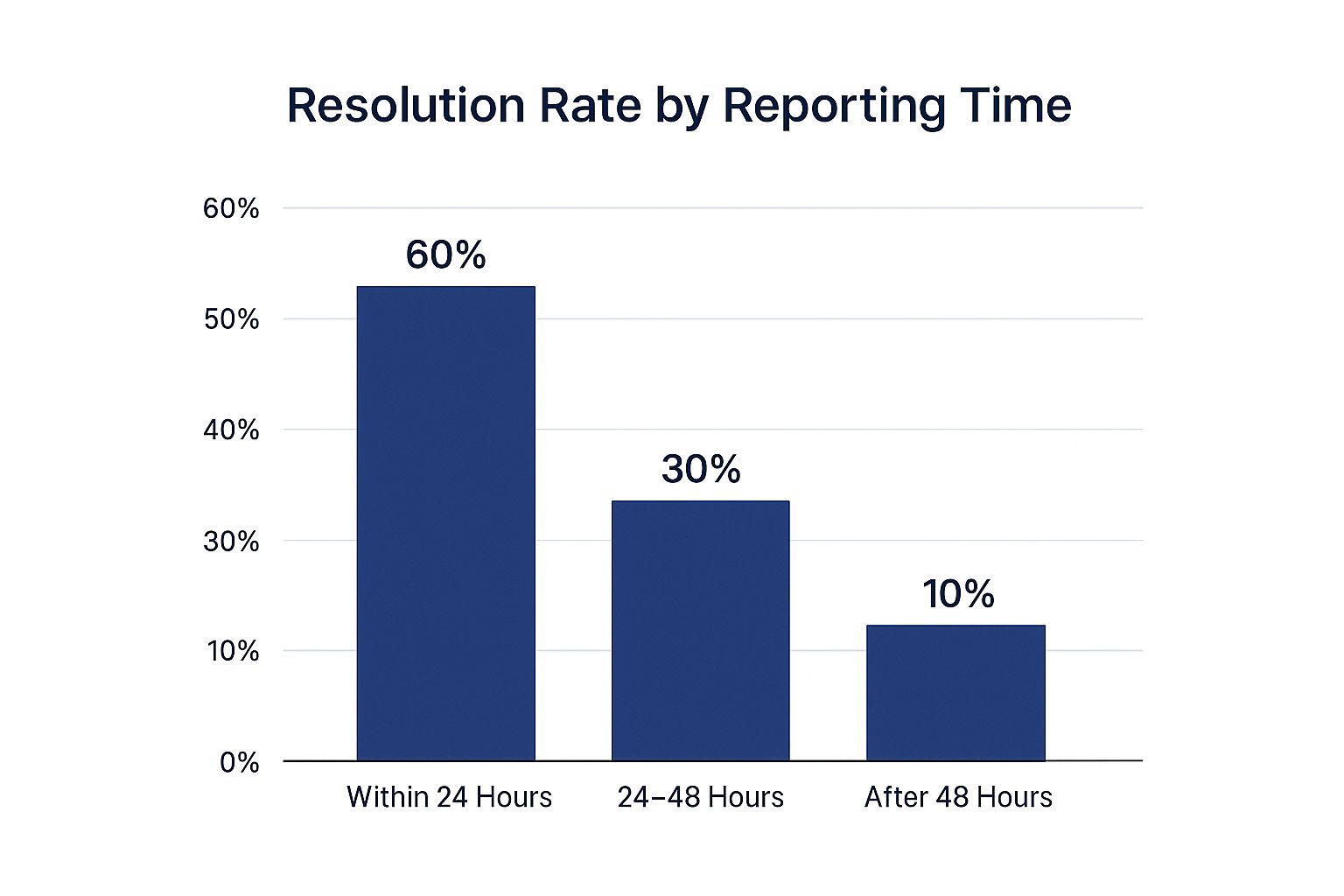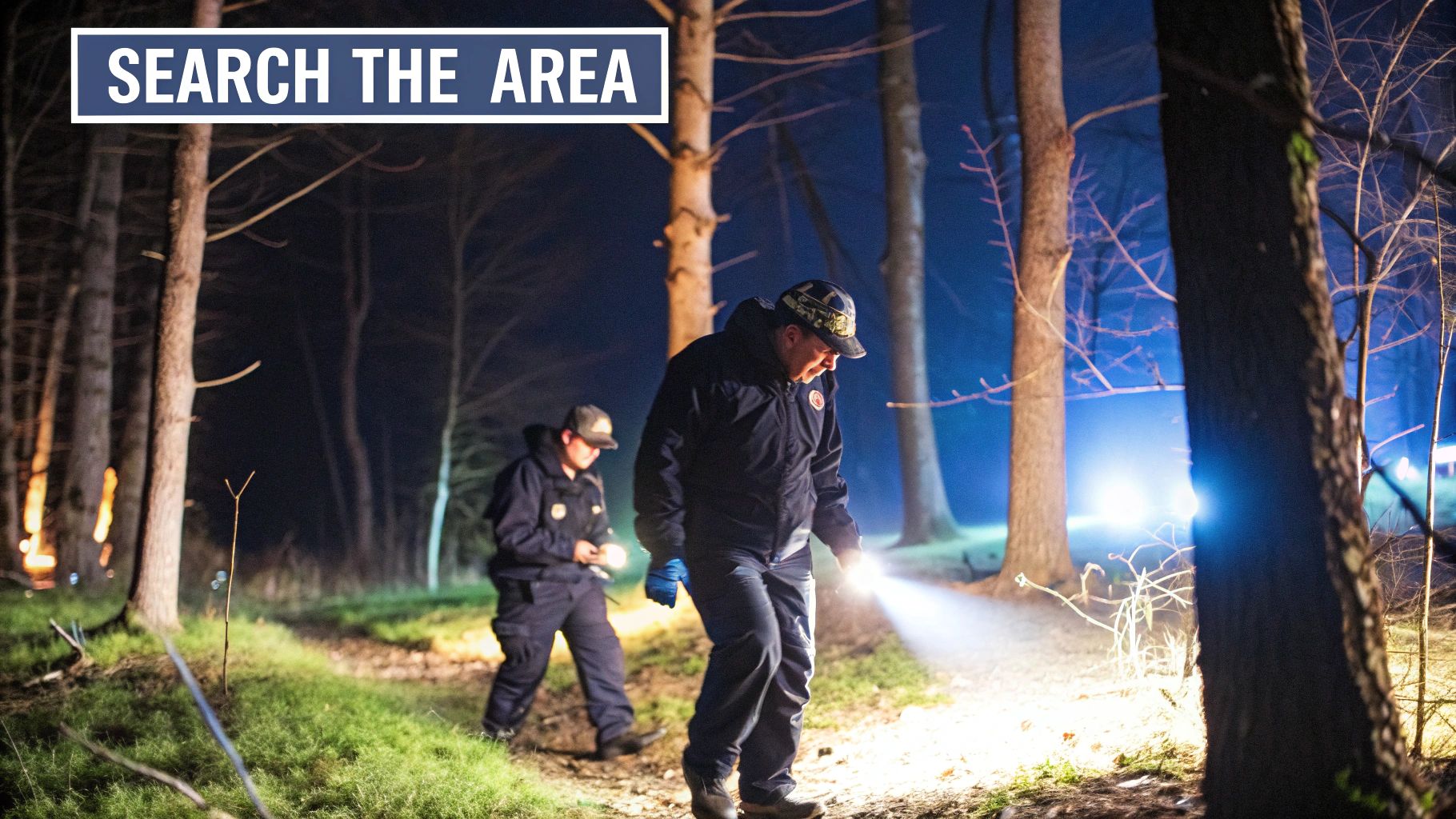How to Find a Missing Person: Expert Tips & Strategies
- Sentry Private Investigators

- May 23
- 13 min read
Updated: Jul 28
The Critical First Hours: Understanding UK Missing Cases
When a loved one goes missing, every moment is precious. The initial hours after a disappearance are undeniably the most critical for a successful recovery. This section explores the complexities of missing person cases in the UK, emphasising why the first 72 hours are so vital.
The First 72 Hours: Why Are They So Crucial?
Immediately following a disappearance, evidence is at its freshest. Witnesses are more likely to recall important details, and the missing person is less likely to have travelled far. This creates a smaller, more manageable initial search area. For instance, CCTV footage is often recorded over after a set time, which makes prompt retrieval essential.
Additionally, the missing person's psychological state plays a significant role. The sooner intervention happens, the higher the chance of preventing harm. Rapid action significantly increases the likelihood of a safe return.
Understanding UK Missing Person Statistics
Locating a missing person in the UK requires coordinated efforts between authorities and organizations. Someone is reported missing every 90 seconds in the UK, totalling over 170,000 reports each year. The majority of missing individuals are children, with approximately 80% located within 24 hours of the report. Organisations such as Missing People and the UK Missing Persons Unit play essential roles in raising awareness and assisting the search process.
These organisations provide support and resources for families, working closely with law enforcement to locate missing individuals. The efficient response and collaboration between these entities are key to successful recoveries. Learn more about missing person statistics here.
Demographic Factors and Their Influence
Specific demographic factors can affect the speed and outcome of a search. Children are often found more quickly than adults because of heightened public concern and prioritised police response. However, vulnerable adults, including those with dementia or mental health conditions, also need immediate attention due to their heightened risk.
Understanding these patterns allows search efforts to be concentrated where they are needed most. This can make all the difference between a quick reunion and a long, distressing search.
Psychological Factors and Likely Locations
Reasons for disappearances vary, from mental health crises to personal conflicts. Taking into account the missing person’s emotional state and relationships can provide valuable clues about their possible location.
For instance, someone struggling with a mental health episode may seek out familiar places, while someone fleeing a conflict might avoid known contacts and locations. Recognising these psychological factors can significantly reduce the search area and focus efforts. This understanding helps prioritise locations and resources, maximising the effectiveness of the search.
Taking Immediate Action: Your First 24 Hours Playbook

The first 24 hours after a person goes missing are the most critical. The initial steps you take can significantly impact the outcome of the search. This playbook, based on the experiences of families who have successfully found their missing loved ones, offers a guide for this crucial period.
Contacting the Police: Essential First Steps
Report the disappearance to your local police immediately. The idea of waiting 24 hours is a dangerous myth. Time is absolutely essential. Have the following information ready:
The missing person's full name, date of birth, and address.
A recent photograph, showing their typical clothing.
Details about their last known location and any planned activities.
Their phone information, including the make, model, and number.
Consider using temporary phone numbers for your privacy during the search. Rent SMS Numbers - United Kingdom is one resource that can help.
Gathering Key Identification Details
Beyond basic information, other details can greatly assist search efforts:
Distinguishing characteristics like tattoos, scars, or birthmarks.
Their usual routines and frequently visited places.
Any medical conditions or necessary medications.
Information about their recent emotional well-being or potential stressors.
These seemingly minor details can provide important clues.
Common Mistakes to Avoid
Some well-intentioned actions can actually hinder investigations. Try to avoid these common mistakes:
Waiting to file a police report.
Disturbing potential evidence in the missing person's room or belongings.
Sharing information on social media before it’s verified, as this can misdirect searches.
Concentrate on gathering accurate information and cooperating with the authorities. This focused approach is the most effective way to support the investigation.
Systematically Checking Likely Locations
While you wait for police action, begin a systematic search of places the missing person is likely to be:
Friends' homes
Their workplace
Usual hangouts
Favourite parks or outdoor areas
Keep a record of your search, including the time and date of each check. This prevents wasted effort and ensures a comprehensive search.
Coordinating Family and Friends
The first 24 hours can be emotionally draining. Working together with family and friends will make the most of everyone's time and energy.
Assign specific tasks, like calling hospitals or making and posting flyers. This organised method ensures that all essential steps are handled quickly and efficiently. Clear and frequent communication is key. Sharing updates promptly keeps everyone on the same page and working towards the same goal.
Navigating the UK Police Response System Effectively
Working with UK law enforcement on a missing person case can be challenging. Understanding their procedures and priorities is essential for navigating the system effectively and advocating for your loved one. This section explains how police respond to missing person cases, providing you with the tools to effectively engage with them.
Understanding Police Prioritisation
UK police use a risk assessment system. When a missing person report is filed, officers gather information to categorise the case based on the individual's vulnerability and the potential dangers they might face. This assessment determines the resources allocated to the search. For instance, a child or vulnerable adult typically receives immediate and extensive attention.

This infographic shows the resolution rate of missing person cases and how quickly they're reported to the police. Reporting a disappearance within the first 24 hours dramatically increases the chances of a successful outcome. A rapid response is critical.
Communicating Effectively With Investigators
Providing clear and concise information is key to ensuring your case remains a priority. Give officers specific details: known routines, recent emotional state, and any potential conflicts. Accurate physical descriptions and recent photographs are incredibly helpful.
Be proactive. Maintain regular contact with the investigating officer, promptly providing any new information and asking for updates on their progress. This consistent communication ensures you stay informed and involved in the process. Consider learning more about the field of investigation: How to master private investigation.
Escalation and Advocacy
If you feel your case isn't receiving adequate attention, it's essential to be persistent while maintaining a professional and respectful approach. Document all communication with the police, including dates, times, and specific details of conversations.
If necessary, escalate your concerns through the appropriate channels within the police force. This could involve speaking with a supervisor or contacting your local Member of Parliament (MP).
To better understand the scale of missing person cases: approximately 180,000 people go missing in the UK each year, with around 353,000 files opened annually. This discrepancy suggests the true number may be higher. For more statistics, see Missing Persons Statistics by Country.
The following table provides more detail about the UK’s police response system:
UK Law Enforcement Response by Risk Level
Risk Level | Definition | Typical Police Response | Timeline |
|---|---|---|---|
High | Immediate risk of harm | Extensive search efforts, media appeals, specialised units involved | Immediate action |
Medium | Potential risk of harm | Targeted inquiries, checks with known associates, local area searches | Within 24 hours |
Low | No immediate risk of harm | Initial inquiries, database checks, follow-up as needed | Varies depending on circumstances |
This table outlines how UK police categorise missing person cases by risk level and the corresponding response protocols for each category. The risk level assigned determines the urgency and extent of the police response.
Considering Additional Resources
Understanding visa statuses and immigration matters can be relevant if the missing person is not a UK citizen. Learn more about the various UK Visa Types. Many organisations specialise in supporting families of missing persons. They offer emotional support, practical advice, and access to wider networks. These resources can be invaluable during a difficult time.
By understanding the police response system and communicating effectively, you can significantly improve the chances of a successful reunion.
Leveraging Specialist Organisations for Maximum Impact
When a loved one goes missing, it's a deeply distressing experience. Leveraging specialist organisations can significantly amplify your search efforts. These organisations offer invaluable resources and expertise that can be crucial during this difficult time. This section explores how to effectively engage with these vital support networks in the UK.
Missing People: A Vital Resource
Missing People is a prominent UK charity offering comprehensive support to missing individuals and their families. They offer a wide range of services, from emotional support and practical advice to publicity campaigns and a confidential helpline. Learning how to access these services can make a real difference in your search.
Crafting an Effective Case Submission
To ensure your case receives prompt attention, clear and concise communication is key. Include all the essential details when contacting these organisations.
High-quality photographs: Recent, clear images are vital for identification.
Detailed physical description: Note any distinguishing features, such as tattoos, scars, or birthmarks.
Last known location and circumstances: This information helps focus initial search efforts.
Background information: Include any relevant details about the missing person’s emotional state, relationships, and daily routines.
Coordinating With Multiple Support Channels
Engaging with multiple organisations can be beneficial, but ensure clear communication between all parties. This prevents duplicated efforts or conflicting information. Designate a primary point of contact to streamline communications and maintain a clear overview of all activities. This coordinated approach maximises efficiency and minimises potential confusion.
Addressing Common Miscommunications
Miscommunication can sometimes arise between families and support organisations. Be proactive in clarifying any uncertainties and maintain regular contact. By addressing potential misunderstandings promptly, you can ensure the search remains focused and effective. You might be interested in: How to master People Tracing.
Maintaining Momentum in Long-Term Cases
As days turn into weeks, maintaining momentum is crucial. The process of finding a missing person in the UK involves a multifaceted approach that includes both public awareness and specialised research. Publicity is essential for raising awareness, often relying on public tips and sightings. Research into issues surrounding missing persons—like mental health and trafficking—is also conducted. For example, about 18% of missing adult incidents are reported from health and care settings, highlighting the importance of these environments. Combining public engagement with in-depth research helps improve strategies for locating and supporting missing persons.
Regularly update information with the organisations involved, and continue sharing appeals through social media and other channels. This persistent effort keeps the case in the public eye and increases the chances of a breakthrough.
Specialist Organisations and Their Focus
Different organisations specialise in specific demographics or types of disappearances. Researching these specialisations helps you identify the most relevant support networks. Some organisations focus on supporting families of children, while others specialise in cases involving mental health issues. Choosing the right organisations maximises the impact of your search efforts.
By understanding the available resources and engaging effectively with specialist organisations, you can significantly improve your chances of finding your missing loved one. These organisations provide vital support, information, and practical assistance, helping you navigate this challenging time.

Creating Digital Search Campaigns That Actually Work
When a loved one goes missing, many people turn to social media for help. However, simply posting a picture isn't enough. Effective digital search campaigns require a well-defined strategy. This section explores digital strategies that have successfully reunited families.
Crafting Effective Social Media Posts
Social media algorithms prioritise engaging content. To maximise your post's reach, keep it clear, concise, and emotionally compelling. Include a high-quality, recent photo of the missing person.
Don't forget crucial details like their name, age, last known location, and any distinguishing features.
Use strong calls to action. Encourage sharing and reporting any sightings.
Use relevant hashtags to boost visibility.
Update the post regularly with new information.
By following these steps, your message can reach a wider audience.
Platform Strategies for Different Demographics
Each social media platform has a different user base. Understanding these demographics improves your campaign's effectiveness. Let's examine some key platforms.
To illustrate this further, take a look at the table below:
Social Media Platforms Effectiveness by Missing Person Demographics
Platform | Best For | Key Features | Posting Strategy | Success Rate |
|---|---|---|---|---|
Reaching a broad audience | Groups, events, sharing | Create a dedicated group, share in local groups, and encourage widespread sharing. | Varies depending on case specifics, engagement, and reach. Can be instrumental in raising awareness and generating leads. | |
Reaching younger audiences | Visual storytelling, hashtags, stories | Share compelling visuals, use relevant hashtags, and post regular story updates. | Strong for visual identification and leveraging influencer networks. Success dependent on visual content quality and hashtag strategy. | |
Real-time updates and news | Retweets, hashtags, direct messaging | Share concise updates, use relevant hashtags, and encourage retweets for rapid dissemination. | Effective for quickly spreading information and reaching media outlets. Success hinges on concise messaging and timely updates. |
This table shows which platforms are most effective for various demographics. By targeting your strategy, you can make the most of each platform’s strengths.
Coordinating Online Volunteers
Online volunteers can be invaluable for expanding your reach. Effective coordination ensures their efforts are focused and efficient.
Create clear guidelines for sharing information.
Establish a central communication hub, such as a dedicated messaging app.
Assign specific tasks to volunteers. This could include managing individual platforms or contacting local media.
This structured approach maximises the impact of volunteer support. For more information on investigations, see: Learn more in our article about covert surveillance operations.
Balancing Privacy and Public Information
Sharing information is essential, but protecting the missing person's privacy is equally important. Avoid sharing sensitive personal details that could be misused. Focus on information relevant to identification and location.
Consult with law enforcement before releasing any potentially sensitive information. This balanced approach supports the search while respecting privacy.
Utilising Digital Forensics
Digital forensics can reveal essential clues from online activity. Examining social media accounts, email, and browsing history can provide insights into their whereabouts or state of mind.
However, accessing private information must be done legally and ethically, ideally with law enforcement guidance. This responsible approach ensures valuable information is obtained legally.
By effectively using digital tools, you can significantly improve your search efforts and increase the chances of reuniting with your loved one. These strategies, alongside traditional search methods and collaboration with law enforcement, provide a comprehensive approach for navigating this challenging situation.
Organising Community Searches That Yield Results

While online efforts are vital in missing person cases, physical searches still play a crucial role. However, well-intentioned but untrained volunteers can sometimes hinder the investigation. This section offers guidance on organising effective community searches that work alongside official efforts.
Mapping Search Zones Strategically
Instead of searching haphazardly, a systematic approach is essential. Work with law enforcement to define the search area. This should be based on the missing person's last known location, probable travel routes, and typical behaviours.
Divide the search area into smaller, manageable grids. This organised method prevents duplicated searches and ensures comprehensive coverage. It mirrors professional search and rescue operations, which prioritise systematic coverage for maximum efficiency.
Managing Volunteer Teams Effectively
Well-defined roles and responsibilities are essential for successful volunteer management. Appoint team leaders to oversee smaller groups within specific search zones. Provide volunteers with clear instructions, maps, and established communication protocols.
This structured organisation helps everyone understand their individual tasks and contributes to a more effective search.
Communication Protocols and Evidence Preservation
Establish clear communication channels between volunteer search teams and law enforcement. Regular check-ins ensure prompt updates and the immediate reporting of potential evidence.
Volunteers need instructions on preserving potential evidence. This includes not touching or moving any objects and carefully marking the location of findings without disturbing them. This careful approach is crucial for protecting the investigation's integrity.
Avoiding Common Search Mistakes
Several common mistakes can hinder a community search:
Inadequate Briefing: Ensure all volunteers receive a thorough briefing before the search begins. This should cover safety protocols, search methods, and communication procedures.
Overlapping Search Areas: Clearly assign specific zones to each team. This prevents wasted effort and ensures complete coverage.
Poor Communication: Maintaining regular updates between teams and with law enforcement is essential for effective coordination.
Evidence Contamination: Emphasise the importance of preserving potential evidence. Provide clear instructions on proper handling procedures.
Avoiding these common pitfalls will result in a smoother, more effective search. Consider available resources that can assist in your search, like those found here.
Implementing Professional Search Techniques
While volunteers aren't trained search and rescue professionals, some basic search techniques can enhance their effectiveness:
Line Searching: Volunteers walk in a straight line, evenly spaced, to methodically cover a designated area. This structured approach helps locate even small details.
Grid Searching: The search area is divided into a grid, with teams assigned to search each section. This systematic approach ensures comprehensive coverage.
These techniques, combined with clear communication and careful evidence preservation, significantly increase the chances of a successful outcome. Balancing the emotional urgency with a strategic approach is key. While the desire to act quickly is natural, a well-organised operation yields the best results.
Sustaining Long-Term Searches Without Losing Hope
When a missing person case stretches beyond the initial weeks and months, the challenges faced by families become even more complex. This section explores the realities of long-term searches, providing support and guidance for navigating this difficult journey.
Maintaining Case Visibility
As time passes, media and public attention can fade. However, keeping the case visible is vital for generating new leads. Here are a few strategies:
Regularly update social media: Share new photos, updated information, and heartfelt pleas to keep the case in the public eye.
Engage with local media: Contact newspapers, radio stations, and TV channels with updates and stories about the missing person. Even small local outlets can be invaluable.
Organize community events: Awareness walks, vigils, or fundraising drives can maintain public awareness and encourage continued support.
These actions can reignite interest and potentially lead to significant breakthroughs.
Managing the Missing Person's Affairs
The practicalities of a long-term disappearance can be overwhelming, including managing finances, property, and legal matters.
Consult a solicitor: A solicitor can advise on legal issues related to the missing person's estate, finances, and guardianship.
Set up a dedicated bank account: This will help manage any incoming funds related to the search or the missing person’s affairs.
Keep detailed records: Document every action taken, communications with authorities, and all financial transactions.
These steps create a structure for managing the missing person's life in their absence.
Recognising Investigative Stagnation and Re-Engaging Authorities
It's common for investigations to slow down. If you feel your case is inactive, re-engaging with law enforcement is essential.
Schedule regular meetings with investigators: Maintain open communication, request updates, and provide any new information.
Make formal requests for information: You have the right to request updates and access to case files (with certain limitations). A formal request can encourage action.
Consider a private investigator: They can offer a new perspective and explore different avenues of investigation.
These measures can help revitalise the search and maintain momentum.
Coping With Ambiguous Loss
The emotional impact of a long-term missing person case is profound. Ambiguous loss, the distress of not knowing whether a loved one is alive or dead, is particularly difficult. Support is essential.
Seek professional counselling: A therapist specialising in grief and trauma can provide coping mechanisms and emotional support.
Connect with support groups: Sharing with others facing similar situations can offer comfort and lessen feelings of isolation.
Prioritise self-care: Looking after your own physical and emotional well-being is crucial during this challenging time.
These actions can build resilience for the long haul.
Maintaining Hope and Continuing Search Efforts
Sustaining hope during a prolonged search can feel impossible, but it's vital for driving search efforts. While acknowledging the difficulties, remember that people are found even after years of being missing. Focus on what you can do, celebrate small successes, and find strength in stories of successful reunions. These stories remind us that hope and perseverance are crucial.
For professional assistance in the UK, consider contacting Sentry Private Investigators Ltd. They offer a range of services to support families during these difficult times.




Comments